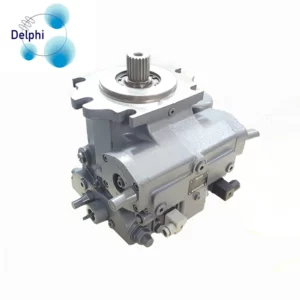The parts list for a Rexroth A6VM hydraulic motor is a valuable resource for diagnosing and addressing common issues or failures within the motor. Here’s how the parts list can assist in this process:
- Identification of Components: The parts list provides a comprehensive list of all the components and parts that make up the A6VM hydraulic motor. This makes it easier to identify specific components that may be contributing to a problem or failure.
- Part Numbers and Descriptions: Each component in the parts list is typically accompanied by a part number and a description. These part numbers are crucial for ordering replacement parts. When diagnosing a problem, you can cross-reference the damaged or malfunctioning component with the parts list to identify the correct replacement part.
- Exploded Diagrams: Many parts lists include exploded diagrams that illustrate how the components are assembled. These diagrams are instrumental in understanding the motor’s internal structure, which can aid in diagnosing issues and identifying the location of a problem.
- Maintenance and Replacement Instructions: In some cases, the parts list may include maintenance or replacement instructions for specific components. This information can guide you through the process of replacing or servicing parts, which is crucial when addressing failures or issues.
- Compatibility Information: The parts list can specify the compatibility of parts, including which components can be used interchangeably or the recommended replacement parts. This ensures that you choose the right parts when addressing failures.
- Quantities and Specifications: The parts list provides information about the quantity of each component used in the hydraulic motor. It may also include specifications like dimensions and material information, which is essential when ordering replacement parts.
- Common Failure Points: Based on experience and industry knowledge, the parts list or accompanying documentation may highlight common failure points within the hydraulic motor. This information can be valuable for diagnosing issues that often arise in the A6VM motor.
- Safety Precautions: The parts list may include safety guidelines and precautions related to servicing or replacing components. This ensures that you follow proper safety procedures when addressing failures.
- Service Contact Information: Some parts lists include contact information for customer support or technical assistance. If you encounter a problem that you cannot diagnose or address independently, this resource can be helpful.
In summary, the parts list for a Rexroth A6VM hydraulic motor serves as a reference guide that provides the necessary information to diagnose and address common issues or failures. It helps you identify components, obtain the correct replacement parts, and understand the motor’s internal structure, all of which are essential for effective troubleshooting and maintenance.
What is the recommended maintenance schedule for the components listed in the parts list?
The recommended maintenance schedule for the components listed in the parts list for a Rexroth A6VM hydraulic motor can vary based on several factors, including the specific model of the motor, the application, and operating conditions. rexroth a6vm parts list Maintenance schedules are typically outlined in the manufacturer’s documentation, including the motor’s user manual or service manual. Here are some general guidelines for creating a maintenance schedule for the components listed in the parts list:
- Regular Inspection: Regular visual inspections of the hydraulic motor are essential. This can include checking for signs of leaks, unusual noise, or any visible damage. The frequency of visual inspections depends on the application and operating conditions but is typically performed daily or weekly.
- Fluid Analysis: If the motor is part of a hydraulic system, regular fluid analysis is crucial. Check the hydraulic fluid for contamination, moisture, and wear particle levels. The frequency of fluid analysis may vary but is often performed every 3 to 6 months.
- Filter Replacement: Filters, including suction and return line filters, need to be replaced or cleaned based on operating conditions. High levels of contamination can reduce motor efficiency and life. The replacement schedule varies, but it is typically every 6 to 12 months or as indicated by pressure drop across the filter.
- Lubrication: Grease or lubrication points on the hydraulic motor need to be maintained according to the manufacturer’s recommendations. Lubrication intervals depend on factors like operating temperature and load, but they are generally scheduled every 3 to 6 months.
- Component Replacement: Specific components, such as seals and bearings, have their own recommended replacement intervals. Refer to the manufacturer’s documentation for these guidelines, as they can vary.
- Environmental Conditions: Operating in extreme conditions, such as high temperatures or exposure to contaminants, may require more frequent maintenance. Ensure that your schedule accounts for these environmental factors.
- Operating Hours: Maintenance schedules are often based on operating hours. Regular maintenance, including inspections, should be performed after a certain number of operating hours, which varies depending on the application. This could be every 500 hours, 1,000 hours, or more.
- Operational Demands: High-demand applications may require more frequent maintenance. Consider the demands of your specific application when determining the schedule.
- Manufacturer’s Recommendations: Always refer to the manufacturer’s recommendations and guidelines for maintenance. These recommendations are specific to the A6VM model and should be followed closely.
- Records and Documentation: Keep detailed records of maintenance activities, including dates, tasks performed, and any issues discovered. This documentation helps in tracking the motor’s health and planning future maintenance.
Ultimately, it’s essential to develop a maintenance schedule that takes into account the motor’s operating conditions and the manufacturer’s guidelines. Regular and proactive maintenance can extend the lifespan of the hydraulic motor, prevent unexpected failures, and optimize its performance.
